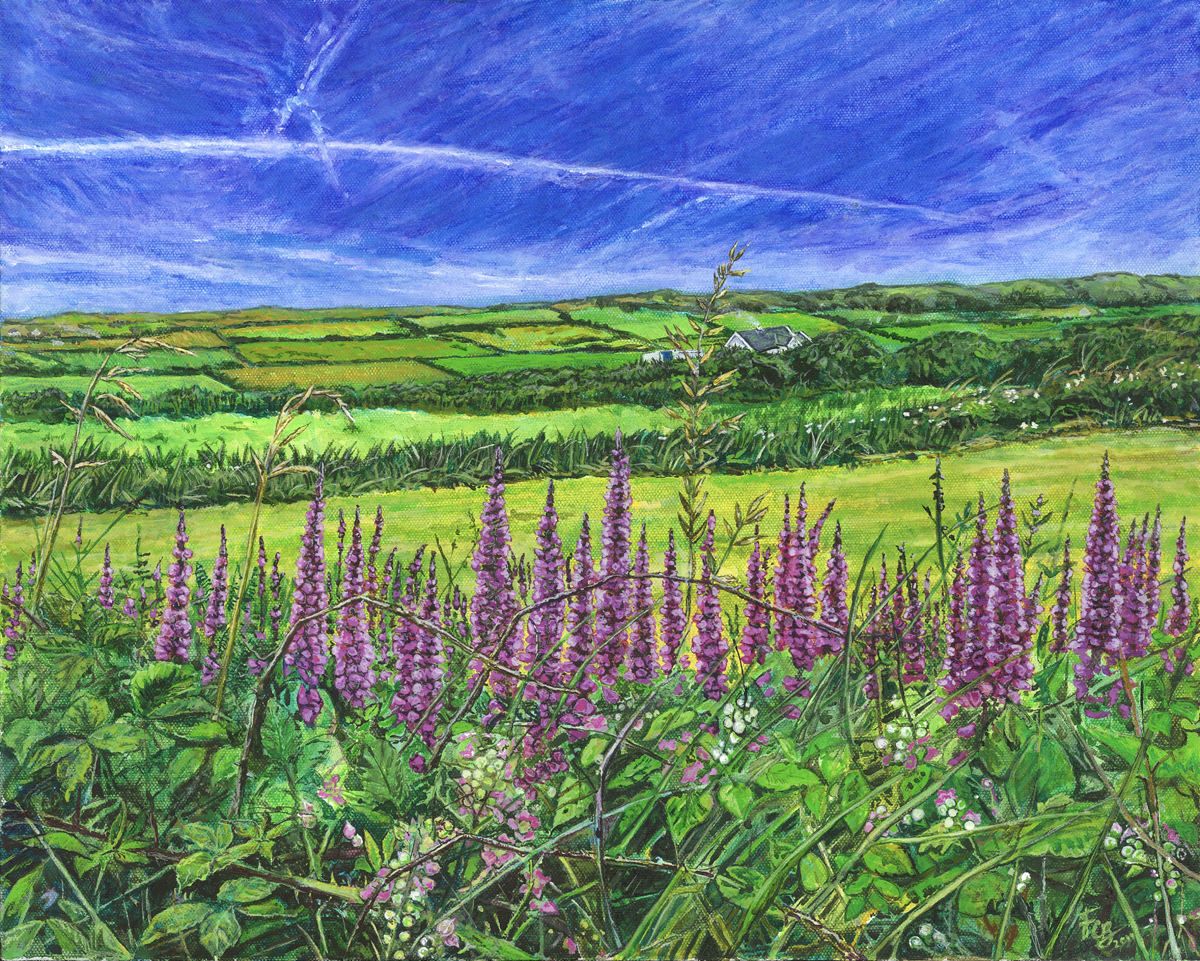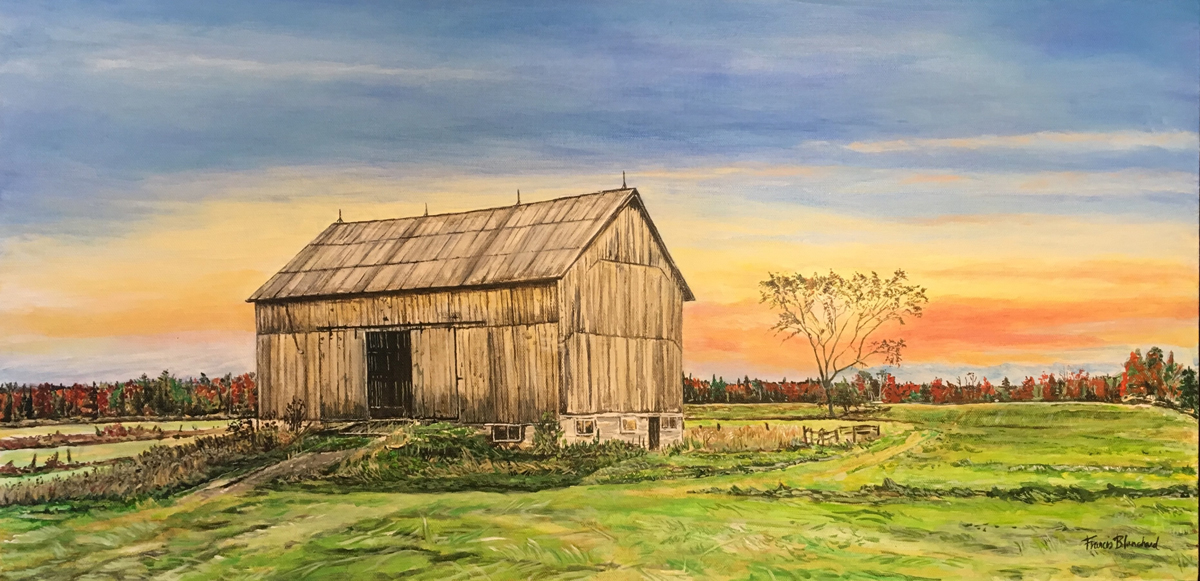
Down the Old Bog Road: Frances Crossan Blanchard
by Kim Fahner, Guest Curator

Sometimes you meet a friend in childhood and somehow lose track of one another, only to come to meet again in middle age. This happened to me. My sister Stacy and I grew up with Frances and her sister, Sheena, in a Sudbury neighbourhood that is known as Minnow Lake. There are photos of us all laughing hysterically and playing together in 1970s era party dresses. We had fun. Life was simpler then, when we were all under ten.
Fast forward to our 40s and Frances and I somehow reconnected via Facebook. She reached out and invited me to spend time writing at her family cottage in County Clare, in a tiny village called Spanish Point. It seemed too generous an invitation, in some ways, so I was hesitant in taking her up on it. In Spring 2018, I was living in Kingsville, Ontario, working on a novel and on a leave from classroom teaching, when she suggested—again, and more persistently this time—that I should take her up on her offer of a stay in County Clare. Her generosity knows no bounds because she has such a big heart. I said yes, finally, and I met her there in September 2018. For two days, she toured me around the countryside of the West of Ireland, showing me her favourite places and introducing me to some of her friends on the Old Bog Road. Then, I stayed on in the cottage by myself for two weeks, writing my novel and some poems, and just letting the Irish landscape influence my work and seep into my soul.
I knew that Frances was an artist. She had given me a couple of her prints as gifts in 2017, all images inspired by her beloved Ireland. Both of her parents were born there, and she bought the family cottage. Her uncle, Martin O’Neill, had lived there all his life. Frances had visited O’Neill Cottage since she was a young girl, but really spent a great deal more time there—in summers—from the time when she turned eighteen. Since her uncle’s death, she’s taken time and great care to bring it back to life, in a tribute to her family ancestry. When you stay in O’Neill Cottage, you see Frances sitting in front of you, but then can feel and sense a group of ancestors standing all around her, thanking her for bringing that homestead back to life. Her paintings, then, are full of details that conjure up stories of her family and the land they lived on.
What draws me to her work is that the land, sea, and skies are alive. Whether they are paintings set on the beach at Spanish Point, or scenes of the pink sea thrift that blooms along the Loop Head cliffs, the light makes its presence known in her work. In this way, it feels to me—as a poet—that she offers hope and light through her art. In the time before the pandemic, Frances and I had plans to have an exhibition of her paintings—alongside some poems I’d written based on those images—somewhere here in Sudbury. We’re still going to do it, once this particular storm has passed, and we have the tentative title of “From Clare to Here: Paintings and Poems.” For now, though, here’s an image of “The Oyster Catchers,” which Frances dedicated to Liam, one of her sons. Underneath it is my ekphrastic poem of the same name:

The Oyster Catchers, Spanish Point
(for Liam)
They bend, like hand-drawn pick-up-sticks,
all long legged and feathered.
Graceful, they peck at the sand of strand,
black rock hovering behind curve of wings.
Underneath, the oysters shift in shells,
try to dig down, not to be caught.
***
Ekphrastic poetry is something I’ve been drawn to since I began writing, and to have a dear friend who is a visual artist living in the same town, well, that felt like it was ‘meant to be.’ Something very Irish and serendipitous, to be sure, had us reconnect as middle-aged women. When we sit and have tea together, we can talk for hours about how our creative processes work, and I’m always fascinated by how her ideas and images come to her. We also both love Ireland, so we talk about that for hours, too.
For Frances, Spanish Point, Lahinch, Loop Head, and Miltown Malbay are places where her family grew from, and her uncle Martin told her stories she remembers still. He knew what the weather would be by looking out to the ocean down at the end of the Old Bog Road. Frances told me, “My Granny used to dance with my Granda in the field down by The Armada, a famous Spanish Point hotel, because they couldn’t afford to go into the pub there.” In her art, then, the elements of her maternal ancestry—of her very heart—come to life in a vibrant way. No one really seems to have left O’Neill Cottage, which speaks to the power of story and family. There’s something ancient and magical about all of it, too, in how Frances captures the spirit of the weather and landscape—from the sweep of the sea and fields, to the paintings that are based on the animals that were on the Irish coins before the Euro arrived, to the painting of the cow that incorporates portions of her uncle’s Massey Ferguson tractor log into the work itself in collage fashion.

As she creates her newer works, she has moved from using a paler, quieter palette—from pastel shades—to embracing much brighter ones. Perhaps, I was thinking the other day, Frances is blooming as she enters fully into a more intimate relationship with herself, with her muse, and with her art. If you’re lucky enough to meet her, you’ll know she glows from the inside out—a lighthouse soul, as I like to say. When I think of my women friends in their mid to late 40s and early 50s—especially the creative ones who paint, sculpt, write, sing, play instruments, or act—I often find myself thinking that we’re much more vibrant and interesting than we ever were in our 30s and early 40s. That’s also a magic thing, to know that you’re beginning to bloom within your chosen art.
Frances started out in Graphic Arts at Cambrian College, but went on into another career. She kept painting, though. In recent years, in her 40s, really, she’s gone back to her painting with a new kind of vigour. I relate to that because my creative writing, during my 40s, has traveled a similar path in terms of how I’ve recommitted myself to it in a passionate and dedicated way. If you sit and talk with Frances, she’ll tell you that she is at peace when she paints, and that the land she most loves tells her a story that she feels compelled to capture in her paintings.
You’ll see these images, these stories, here in the paintings she’s sharing with you in The Covert Collective. Remember to look to the land, the sea, and the sky on her canvases because that is where you’ll find Frances and her bright, lighthouse heart—painted into the places that tell her stories in a vibrant, loving tribute to her origin place. For my part, I feel blessed to have met her again—after such a long time apart—and to have a friend who understands that landscape, art, and poetry are elemental, creative, ancient forces that feel to have come from some other place, from some other time. Frances and I come from long lines of strong Irish women, and that is something we share, as well. Funny, how those shades of the women who went before us are so present in our work, too, in a way that bind us together as friends and kindred, creative spirits.

Writer

Guest Curator Kim Fahner lives and writes in Sudbury, Ontario. She was poet laureate for the City of Greater Sudbury from 2016-18 and was the first woman appointed to the role. Her latest book of poems is These Wings (Pedlar Press, 2019). Her next book of poems, Emptying the Ocean, will be published by Frontenac House Press, in Calgary, in Fall 2022. Currently, Kim is finishing a new play and working on a series of bee poems. She is a member of the League of Canadian Poets, the Ontario Representative of The Writers’ Union of Canada, and a supporting member of the Playwrights Guild of Canada. In 2021, Kim won first place in the League of Canadian Poets’ Broadsheet Contest for her poem, “Beekeeping.” She may be reached via her author website at www.kimfahner.com
Artist

Frances Crossan Blanchard is a contemporary artist who is a dual citizen of both Canada and Ireland. Her cottage art studio by the sea in Spanish Point, County Clare—which has been in her family for centuries—provides a constant source of inspiration for her paintings. All her work focuses on landscape and wildlife. A strong love of place is present in all her paintings.
Frances’ graphic arts and design training at Cambrian College in Sudbury, Ontario has influenced the storytelling aspect that finds its way through each piece she paints. Whether the idea is sparked by a story passed down through generations, an experience she wishes to relive, or a vision of a place where she finds comfort, all her paintings have been thoroughly researched.
~ Posted by Kim Fahner